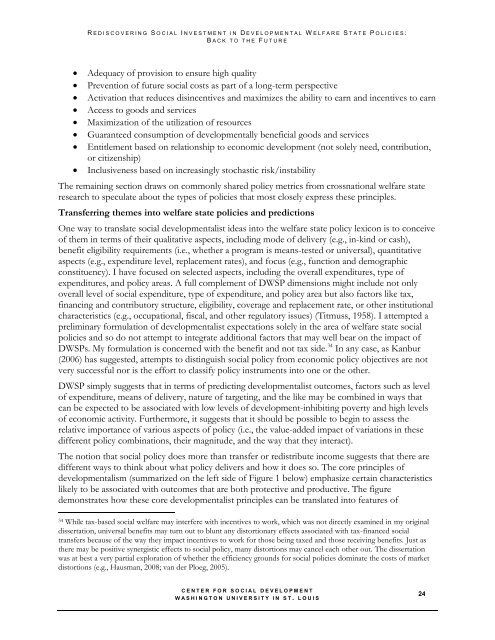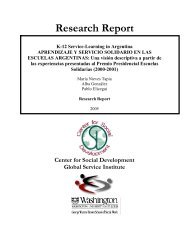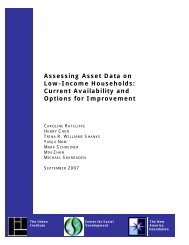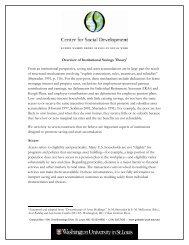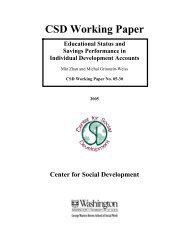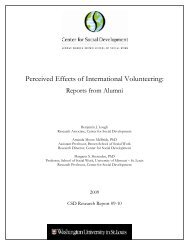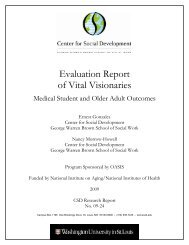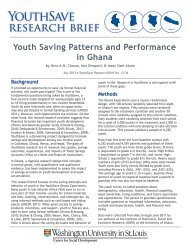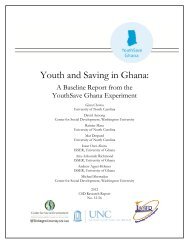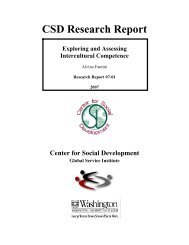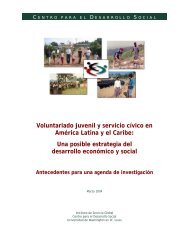Rediscovering social investment in developmental welfare state ...
Rediscovering social investment in developmental welfare state ...
Rediscovering social investment in developmental welfare state ...
Create successful ePaper yourself
Turn your PDF publications into a flip-book with our unique Google optimized e-Paper software.
R E D I S C O V E R I N G S O C I A L I N V E S T M E N T I N D E V E L O P M E N T A L W E L F A R E S T A T E P O L I C I E S :<br />
B A C K T O T H E F U T U R E<br />
<br />
<br />
<br />
<br />
<br />
<br />
<br />
<br />
Adequacy of provision to ensure high quality<br />
Prevention of future <strong>social</strong> costs as part of a long-term perspective<br />
Activation that reduces dis<strong>in</strong>centives and maximizes the ability to earn and <strong>in</strong>centives to earn<br />
Access to goods and services<br />
Maximization of the utilization of resources<br />
Guaranteed consumption of <strong>developmental</strong>ly beneficial goods and services<br />
Entitlement based on relationship to economic development (not solely need, contribution,<br />
or citizenship)<br />
Inclusiveness based on <strong>in</strong>creas<strong>in</strong>gly stochastic risk/<strong>in</strong>stability<br />
The rema<strong>in</strong><strong>in</strong>g section draws on commonly shared policy metrics from crossnational <strong>welfare</strong> <strong>state</strong><br />
research to speculate about the types of policies that most closely express these pr<strong>in</strong>ciples.<br />
Transferr<strong>in</strong>g themes <strong>in</strong>to <strong>welfare</strong> <strong>state</strong> policies and predictions<br />
One way to translate <strong>social</strong> <strong>developmental</strong>ist ideas <strong>in</strong>to the <strong>welfare</strong> <strong>state</strong> policy lexicon is to conceive<br />
of them <strong>in</strong> terms of their qualitative aspects, <strong>in</strong>clud<strong>in</strong>g mode of delivery (e.g., <strong>in</strong>-k<strong>in</strong>d or cash),<br />
benefit eligibility requirements (i.e., whether a program is means-tested or universal), quantitative<br />
aspects (e.g., expenditure level, replacement rates), and focus (e.g., function and demographic<br />
constituency). I have focused on selected aspects, <strong>in</strong>clud<strong>in</strong>g the overall expenditures, type of<br />
expenditures, and policy areas. A full complement of DWSP dimensions might <strong>in</strong>clude not only<br />
overall level of <strong>social</strong> expenditure, type of expenditure, and policy area but also factors like tax,<br />
f<strong>in</strong>anc<strong>in</strong>g and contributory structure, eligibility, coverage and replacement rate, or other <strong>in</strong>stitutional<br />
characteristics (e.g., occupational, fiscal, and other regulatory issues) (Titmuss, 1958). I attempted a<br />
prelim<strong>in</strong>ary formulation of <strong>developmental</strong>ist expectations solely <strong>in</strong> the area of <strong>welfare</strong> <strong>state</strong> <strong>social</strong><br />
policies and so do not attempt to <strong>in</strong>tegrate additional factors that may well bear on the impact of<br />
DWSPs. My formulation is concerned with the benefit and not tax side. 34 In any case, as Kanbur<br />
(2006) has suggested, attempts to dist<strong>in</strong>guish <strong>social</strong> policy from economic policy objectives are not<br />
very successful nor is the effort to classify policy <strong>in</strong>struments <strong>in</strong>to one or the other.<br />
DWSP simply suggests that <strong>in</strong> terms of predict<strong>in</strong>g <strong>developmental</strong>ist outcomes, factors such as level<br />
of expenditure, means of delivery, nature of target<strong>in</strong>g, and the like may be comb<strong>in</strong>ed <strong>in</strong> ways that<br />
can be expected to be associated with low levels of development-<strong>in</strong>hibit<strong>in</strong>g poverty and high levels<br />
of economic activity. Furthermore, it suggests that it should be possible to beg<strong>in</strong> to assess the<br />
relative importance of various aspects of policy (i.e., the value-added impact of variations <strong>in</strong> these<br />
different policy comb<strong>in</strong>ations, their magnitude, and the way that they <strong>in</strong>teract).<br />
The notion that <strong>social</strong> policy does more than transfer or redistribute <strong>in</strong>come suggests that there are<br />
different ways to th<strong>in</strong>k about what policy delivers and how it does so. The core pr<strong>in</strong>ciples of<br />
<strong>developmental</strong>ism (summarized on the left side of Figure 1 below) emphasize certa<strong>in</strong> characteristics<br />
likely to be associated with outcomes that are both protective and productive. The figure<br />
demonstrates how these core <strong>developmental</strong>ist pr<strong>in</strong>ciples can be translated <strong>in</strong>to features of<br />
34 While tax-based <strong>social</strong> <strong>welfare</strong> may <strong>in</strong>terfere with <strong>in</strong>centives to work, which was not directly exam<strong>in</strong>ed <strong>in</strong> my orig<strong>in</strong>al<br />
dissertation, universal benefits may turn out to blunt any distortionary effects associated with tax-f<strong>in</strong>anced <strong>social</strong><br />
transfers because of the way they impact <strong>in</strong>centives to work for those be<strong>in</strong>g taxed and those receiv<strong>in</strong>g benefits. Just as<br />
there may be positive synergistic effects to <strong>social</strong> policy, many distortions may cancel each other out. The dissertation<br />
was at best a very partial exploration of whether the efficiency grounds for <strong>social</strong> policies dom<strong>in</strong>ate the costs of market<br />
distortions (e.g., Hausman, 2008; van der Ploeg, 2005).<br />
C E N T E R F O R S O C I A L D E V E L O P M E N T<br />
W A S H I N G T O N U N I V E R S I T Y I N S T . L O U I S<br />
24


